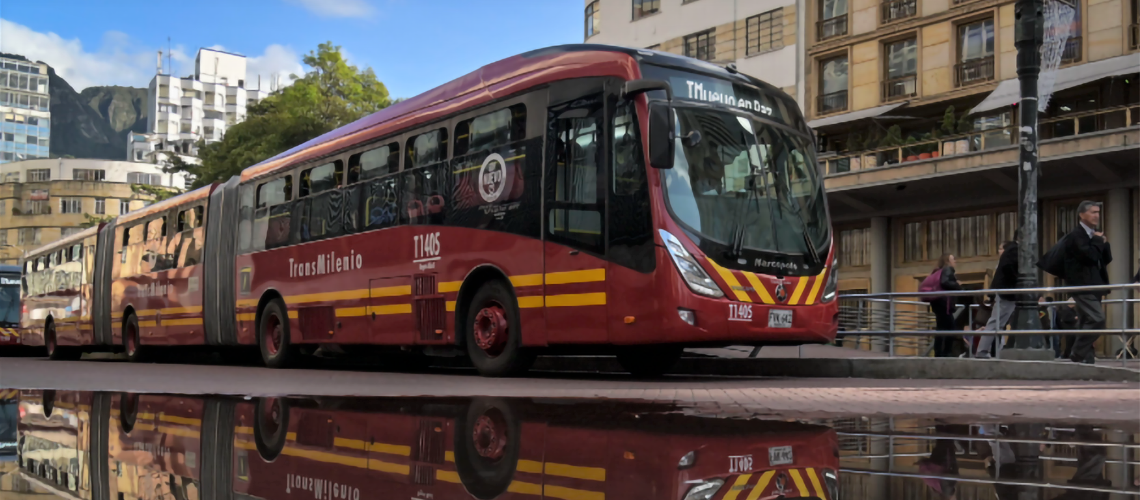 The Bogota Transmilenio bus rapid transit system. Photo credit: World Bank Group
The Bogota Transmilenio bus rapid transit system. Photo credit: World Bank Group
In the 1990s, Colombian cities were grappling with a wide range of transport challenges, most of which are all too familiar to the residents of urban areas around the world: chronic traffic congestion, alarming rates of road fatalities, and inadequate public transit. In a country where about three quarters of the population lives in cities, the shortcomings of the urban transport system had far-reaching consequences on economic productivity and kept many people away from jobs, education, healthcare, or other essential services.
Colombia decided to tackle the problem head-on. From the turn of the century, national and local governments have implemented a series of strategies to rethink urban mobility in the country’s fourteen largest cities, with a clear focus on mass transit, active mobility, road safety, and improved traffic management. The successive plans have been widely recognized for their comprehensive and ambitious nature, making Colombia a laboratory of urban transport innovation that has inspired many developing countries.
The change is visible as soon as you land in the city. On the main avenue connecting the airport to the central district, several lanes of traffic are now dedicated exclusively to high-capacity, high-frequency buses that provide fast and consistent journey times. This Bus Rapid Transit system, known locally as TransMilenio, has become a symbol of Colombia’s approach to urban mobility and city planning—an approach that prioritizes moving people instead of moving cars, including by reallocating public space to mass transit and other sustainable transport modes.
While other cities had experimented with BRT before the creation of TransMilenio, Bogotá was among the first major urban areas to deploy this technology on such a large scale. The network has been growing steadily since the opening of the first line in 2000. Today, the system boasts some 114 km of exclusive BRT corridors and 147 stations scattered all across the city, with several additional lines under planning or construction. Wherever you go in Bogotá, it is hard to miss the bright red TransMilenio buses plying the streets, or the continuous flow of commuters walking briskly to and from the stations. In 2019, it was estimated that 2.6 million of them used the system each day. The success of Transmilenio has considerably strengthened the case for Bus Rapid Transit and led several of the world’s largest, most congested cities to build their own BRT systems.
Bogotá’s local bus routes have received a major overhaul as well. Since 2011, informal bus services have been streamlined into a safe, coherent, and user-friendly network that reaches virtually every corner of the city. This Integrated Public Transport System (SITP) features well-designed stops, bus priority lanes, an advanced user information system, and a modern vehicle fleet—including a record-breaking 900 electric buses. The formalization program has significantly improved transport conditions for passengers, while giving operators a predictable revenue stream. Three years ago, the city also inaugurated its first urban aerial cable car, which directly connects low-income hillside communities to the TransMilenio network.
Of course, some challenges remain. Bogotá still ranks among the most congested cities in Latin America, with commuters wasting an average 94 hours a year sitting in traffic. Public transport users are feeling the squeeze, too: the popularity of TransMilenio has led to severe overcrowding, and adding capacity will be difficult.
That is why all eyes are now on another project that will revolutionize how people get around the city: the first line of the Bogotá Metro. Construction on the initial phase has officially begun, and trains are expected to start running by 2027. Once operational, the metro will carry up to 600,000 daily passengers, providing a huge capacity boost to Bogotá’s transit system. The new metro line will become the backbone of the urban transport network and offer seamless connection opportunities to other mass transit services.
The government leaders I met during my mission shared a great deal of enthusiasm about the potential of the project. The anticipation is fully justified. In a sprawling metropolis like Bogotá, the introduction of a fast and efficient metro system means access to more jobs and opportunities, faster commutes, a stronger local economy, and less pollution. All of this will make a significant difference in the daily lives of Bogotanos.
In addition to mass transit investment, the city has adopted several important policies that will further support the transition toward sustainable urban transport. Cycling, in particular, has been a key priority. Back in 2019, residents already had 583 km of bike lanes at their disposal and took over 800,000 cycling trips per day (9 percent of daily trips), making Bogotá one of the most bike-friendly cities in the developing world. The pandemic has only accelerated this trend, with the latest plans calling for a total of 830 km of bike lanes by 2024. In parallel, authorities have been actively working to regulate private car use, including by restricting vehicle access to the city center during rush hour and by introducing new charges for on-street parking.
The World Bank has supported many of these transformations. This includes sustained financial assistance to the city’s mass transit projects, first for TransMilenio and now for the future metro, starting with a commitment of up to $600 million toward Line 1. In addition, our experts have been providing technical assistance to several other mobility programs in Bogotá, from the implementation of the SITP bus network to the deployment of a transport subsidy for low-income residents, the creation of innovative models to manage transport demand, and the proposed development of mixed use, dense and well-designed neighborhoods around transit stations.
We are excited to continue this work, which promises to bring considerable benefits. Metro Line 1, for instance, will give residents access to an additional 28,000 jobs, save over 37,500 tons of CO2 a year, and increase economic output by up to 4 percent. Plans for a second metro line are progressing rapidly, with the city aiming to award the construction contract by late 2023. We have been collaborating with our local counterparts to identify how we can support the Line 2 project with both technical assistance and financing.
The changes happening in Bogotá send a compelling message about the potential of sustainable transport for people, the planet, and the economy. Whether it be expanding mass transit, promoting cycling and walking, or supporting the transition to zero-emission vehicles, there are many avenues for countries to make their transport systems cleaner and more efficient while boosting economic growth and improving lives.
At the World Bank, we firmly believe that greener, more inclusive mobility can be a development win-win. And we stand ready to help countries harness the power of sustainable transport, in Colombia and around the world.


Join the Conversation